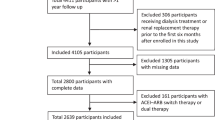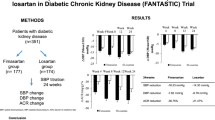Abstract
Type 2 diabetes is the most common cause of end-stage renal disease in the United States, and type 2 diabetes has been shown to be a myocardial infarction equivalent in regard to risk of death from a cardiovascular event. Proteinuria is a surrogate marker for renal disease progression, and although data favor both the angiotensin converting enzyme (ACE) inhibitors and angiotensin receptor blockers (ARBs) in reducing proteinuria, data for renal outcomes, such as time to dialysis, only exist for the ARBs, which clearly increase the duration to dialysis. Conversely, ACE inhibitors have overwhelming data that show substantial risk reduction from cardiovascular events and death in people with type 2 diabetes. Similar data on cardiovascular risk reduction are not yet available with ARBs, although two trials of renal disease progression did have cardiovascular endpoints as secondary outcomes. There were no significant differences between the ARB and control group except for first hospitalization with heart failure, where losartan reduced the risk by 32%, but there was a trend, albeit not significant, toward reduction of myocardial infarction. The first information regarding ARB effects on cardiovascular events as primary outcomes will come from the Losartan Intervention for Endpoint (LIFE) Reduction in Hypertension study. Therefore, as of this writing, all patients with type 2 diabetes and no evidence of nephropathy, ie, proteinuria and an elevated creatinine > 1.5 mg/dL, should be placed on an ACE inhibitor for cardiovascular risk reduction. If nephropathy is present, the evidence would support an ARB for therapy in concert with a â-blocker for cardiovascular risk reduction and renoprotection.
Similar content being viewed by others
References and Recommended Reading
US Renal Data System, USRDS 2001 Annual Data Report: Atlas of End-Stage Renal Disease in the United States. Bethesda, MD: National Institutes of Health, National Institute of Diabetes and Digestive and Kidney Diseases; 2001.
Position statement: diabetic nephropathy. Diabetes Care 2001, 24. A position statement put out by the American Diabetes Association that summarizes the epidemiology, natural history, screening, and treatment of diabetic nephropathy.
Vora JP, Dolben J, Dean JD, et al.: Renal hemodynamics in newly presenting non-insulin dependent diabetes mellitus. Kidney Int 1992, 41:829–835.
Nowack R, Raum E, Blum W, Ritz E: Renal hemodynamics in recent-onset type II diabetes. Am J Kidney Dis 1992, 20:342–347.
St. Peter WL, Lewis MJ: Chronic renal insufficiency and endstage renal disease. In Pharmacotherapy. Edited by DiPiro JT, Yee GC, Matzke GR, et al. Stamford, CT: Appleton & Lange; 1999:732–770.
Hayashi K, Epstein M, Loutzenhiser R, Forster H: Impaired myogenic responsiveness of the afferent arteriole in streptozotocin-induced diabetic rats: role of eicosanoid derangements. J Am Soc Nephrol 1992, 2:1578–1586.
Brown SA, Walton CL, Crawford P, Bakris GL: Long-term effects of antihypertensive regimens on renal hemodynamics and proteinuria. Kidney Int 1993, 43:1210–1218.
Anderson S, Rennke HG, Brenner BM: Therapeutic advantage of converting enzyme inhibitors in arresting progressive renal disease associated with systemic hypertension in the rat. J Clin Invest 1986, 77:1993–2000.
Levey AS: Controlling the epidemic of cardiovascular disease in chronic renal disease: where do we start? Am J Kidney Dis 1998, 32:S5-S13. A comprehensive review article exploring the epidemiology of cardiovascular disease in patients with renal disease, and recommended treatment.
Mogensen CE, Hansen KW, Pedersen MM, Christensen CK:Renal factors influencing blood pressure threshold and choice of treatment for hypertension in IDDM. Diabetes Care 1991, 14(Suppl 4):13–26.
The sixth Report of the Joint National Committee on Prevention, Detection, Evaluation, and Treatment of High Blood Pressure. Arch Intern Med 1997, 157:2413–2446.
Bakris GL, Williams M, Dworkin L, et al.: Preserving renal function in adults with hypertension and diabetes: a consensus approach. Am J Kidney Dis 2000, 36:646–661. A report from the National Kidney Foundation that reviews data from major clinical trials involving blood pressure control that were designed as randomized, prospective, long-term studies that had as a primary endpoint either progression of diabetic nephropathy or reduction in cardiovascular events. This report updates previous recommendations with a focus on level of blood pressure control, proteinuria reduction, and therapeutic approaches to achieve these goals.
Keane WF, Eknoyan G: Proteinuria, albuminuria, risk, assessment, detection, elimination (PARADE): a position paper of the National Kidney Foundation. Am J Kidney Dis 1999, 33:1004–1010. A report from the National Kidney Foundation that reviews the evidence related to proteinuria as a risk factor for cardiovascular disease, proteinuria as a mediator and marker of progressive kidney disease, and persistent massive proteinuria as the inciting factor that leads to the nephrotic syndrome.
Carella MJ, Gossain VV, Rovner DR: Early diabetic nephropathy. Emerging treatment options. Arch Intern Med 1994, 154:625–630.
Ray PE, Aguilera G, Kopp JB, et al.: Angiotensin II receptormediated proliferation of cultured human fetal mesangial cells. Kidney Int 1991, 40:764–771.
Bakris GL, Bhandaru S, Akerstrom V, Re RN: ACE inhibitormediated attenuation of mesangial cell growth. A role for endothelin. Am J Hypertens 1994, 7:583–590.
Bakris G, Kilaru P: ACE inhibition or calcium channel blockade: renal implications of combination therapy versus a single agent. J Cardiovasc Pharmacol 1996, 28:S34-S44.
Ichikawi I, Harris RC: Angiotensin actions in the kidney: renewed insight into the old hormone. Kidney Int 1991, 40:583–596.
Anderson S, Rennke HG, Garcia DL, Brenner BM: Short and long term effects of antihypertensive therapy in the diabetic rat. Kidney Int 1989, 36:526–536.
Lewis EJ, Hunsicker LG, Bain RP, Rohde RD: The effect of angiotensin-converting-enzyme inhibition on diabetic nephropathy. The Collaborative Study Group. N Engl J Med 1993, 329:1456–1462.
Hebert LA, Bain RP, Verme D, et al.: Remission of nephrotic range proteinuria in type I diabetes. Collaborative Study Group. Kidney Int 1994, 46:1688–1693.
Lebovitz HE, Wiegmann TB, Cnaan A, et al.: Renal protective effects of enalapril in hypertensive NIDDM: role of baseline albuminuria. Kidney Int Suppl 1994, 45:S150-S155.
Bakris GL, Copley JB, Vicknair N, et al.: Calcium channel blockers versus other antihypertensive therapies on progression of NIDDM associated nephropathy. Kidney Int 1996, 50:1641–1650.
Chan JC, Ko GT, Leung DH, et al.: Long-term effects of angiotensin-converting enzyme inhibition and metabolic control in hypertensive type 2 diabetic patients. Kidney Int 2000, 57:590–600.
Nielsen FS, Rossing P, Gall MA, et al.: Long-term effect of lisinopril and atenolol on kidney function in hypertensive NIDDM subjects with diabetic nephropathy. Diabetes 1997, 46:1182–1188.
Liou HH, Huang TP, Campese VM: Effect of long-term therapy with captopril on proteinuria and renal function in patients with non-insulin-dependent diabetes and with non-diabetic renal diseases. Nephron 1995, 69:41–48.
Lewis EJ, Hunsicker LG, Clarke WR, et al.: Renoprotective effect of the angiotensin-receptor antagonist irbesartan in patients with nephropathy due to type 2 diabetes. N Engl J Med 2001, 345:851–860. Reports the result of a large trial in which 1715 participants were randomized to an ARB (irbesartan), dihydropyridine calcium channel blocker (amlodipine), or placebo and followed for a mean of 2.6 years. It was found that treatment with irbesartan was associated with a risk of the primary composite endpoint that was 20% lower than that in the placebo group (P = 0.02) and 23% lower than in the amlodipine group (P = 0.006), independent of level of blood pressure reduction.
Brenner BM, Cooper ME, de Zeeuw D, et al.: Effects of losartan on renal and cardiovascular outcomes in patients with type 2 diabetes and nephropathy. N Engl J Med 2001, 345:861–869. Reports the result of a large trial in which 1513 participants were randomized to an ARB (losartan) or placebo and followed for a mean of 3.4 years. It was found that treatment with losartan reduced the risk of the primary endpoint by 16% (P = 0.02) and reduced the risk of ESRD by 28% (P = 0.002), independent of level of blood pressure reduction.
Nelson RG KW, Pettit DJ, Bennett PH: Kidney disease in diabetes. In Diabetes in America. Bethesda, MD: National Institutes of Health; 1995:349–400.
Davis TM, Millns H, Stratton IM, et al.: Risk factors for stroke in type 2 diabetes mellitus: United Kingdom Prospective Diabetes Study (UKPDS) 29. Arch Intern Med 1999, 159:1097–1103.
Dinneen SF, Gerstein HC: The association of microalbuminuria and mortality in non-insulin-dependent diabetes mellitus. A systematic overview of the literature. Arch Intern Med 1997, 157:1413–1418.
Effects of ramipril on cardiovascular and microvascular outcomes in people with diabetes mellitus: results of the HOPE study and MICRO-HOPE substudy. Heart Outcomes Prevention Evaluation Study Investigators. Lancet 2000, 355:253–259. Reports the result of a substudy of the HOPE study from 3577 people with diabetes and one other cardiovascular risk factor who were randomized to either an ACE inhibitor (ramipril) or placebo and followed for a mean of 4.5 years. Ramipril lowered the risk of the combined primary outcome by 25% (P = 0.0004), which was a greater benefit than that attributable to blood pressure reduction.
Estacio RO, Jeffers BW, Hiatt WR, et al.: The effect of nisoldipine as compared with enalapril on cardiovascular outcomes in patients with non-insulin-dependent diabetes and hypertension. N Engl J Med 1998, 338:645–652.
Efficacy of atenolol and captopril in reducing risk of macrovascular and microvascular complications in type 2 diabetes: UKPDS 39. UK Prospective Diabetes Study Group. BMJ 1998, 317:713–720.
Hansson L, Lindholm LH, Niskanen L, et al.: Effect of angiotensin-converting-enzyme inhibition compared with conventional therapy on cardiovascular morbidity and mortality in hypertension: the Captopril Prevention Project (CAPPP) randomised trial. Lancet 1999, 353:611–616.
Lindholm LH, Hansson L, Ekbom T, et al.: Comparison of antihypertensive treatments in preventing cardiovascular events in elderly diabetic patients: results from the Swedish Trial in Old Patients with Hypertension-2. STOP Hypertension-2 Study Group. J Hypertens 2000, 18:1671–1675.
Haffner SM, Lehto S, Ronnemaa T, et al.: Mortality from coronary heart disease in subjects with type 2 diabetes and in nondiabetic subjects with and without prior myocardial infarction. N Engl J Med 1998, 339:229–234. Reports the results of a study that compared the 7-year incidence of myocardial infarction (fatal and nonfatal) among 1373 nondiabetic subjects with the incidence among 1059 diabetic subjects and found that the hazard ratio for death from coronary heart disease between the two populations was not significantly different (hazard ratio, 1.4; 95% CI, 0.7-2.6), which suggests that diabetic patients without a history of myocardial infarction have as high a risk of myocardial infarction as nondiabetic patients with previous myocardial infarction.
Dahlof B, Devereux RB, Julius S, et al.: Characteristics of 9194 patients with left ventricular hypertrophy: the LIFE study. Losartan Intervention For Endpoint Reduction in Hypertension. Hypertension 1998, 32:989–997.
Author information
Authors and Affiliations
Rights and permissions
About this article
Cite this article
Garg, J., Bakris, G.L. Angiotensin converting enzyme inhibitors or angiotensin receptor blockers in nephropathy from type 2 diabetes. Current Science Inc 4, 185–190 (2002). https://doi.org/10.1007/s11906-002-0005-6
Issue Date:
DOI: https://doi.org/10.1007/s11906-002-0005-6




